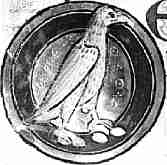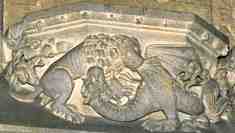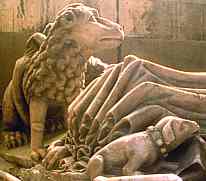





If you are looking at this page without frames, there is more information about medieval writing to be found by going to the home page (framed) or the site map (no frames).
| Bestiaries | ||||
| While some works of the Latin Classics were carefully and accurately transcribed for their value as exemplars of the Latin language, other works from the Classical era became incorporated into medieval literature. Sometimes mistranscribed, mistranslated or misunderstood, they were then adorned with various additions to become something completely different and part of a living, growing literary tradition in the medieval era. Possibly the most delightful of this genre is the category of works known as the bestiary. This class of work is also a good example for contemplation of the difference between medieval literary and practical knowledge. | ||||
| For further information see White 1954, also Barber 1993 which provides an English translation of a bestiary with facsimile illustrations. The Aberdeen Bestiary website gives a full facsimile reproduction, transcription, translation and commentary on a 13th century manuscript bestiary, and it's an absolute beauty. The Bibliothèque nationale de France has an exquisite online exhibition Bestiaire. The Medieval Bestiary provides images and information on the bestiary animals, and catalogues of bestiary manuscripts. The Getty Museum provides digital facsimiles of the miniatures from several bestiary manuscripts. Just type bestiary into the search box or work through their Exhibition Guide. | ||||
| The bestiary was a book of animals, but it was not a natural history description, although somewhere way back in the ancient past and from exotic lands, some such scientific observation was buried in its kernel. It was fundamentally a book of Christian morality, dressed in allegorical clothing. Every animal in it had some moral dimension, or Christian allusion that could be drawn from its behaviour. However, the behaviour of the animals as reported was in many cases truly bizarre and some of the animals were a little odd too. |  |
|||
| A partridge from a 12th century bestiary (British Library, Royal 12 c XIV, f.52v). It is described as an immoral bird which steals the eggs of others. By permission of the British Library. | ||||
 |
The bestiary was a Latin text, designed for the literate clergy and no doubt extensively used for morality sermons and stories. By the 13th century, lavishly illustrated bestiaries were being produced, particularly in England. The imagery of the bestiary was translated into the visual culture of the church, with bestiary creatures adorning the paintings, carvings and stained glass in the churches. As with other works that were mainly read by the clergy, the ordinary people were informed through a combination of oral teaching and visual presentation. | |||
| An elephant carrying a castle turret on its back, as described and illustrated in the bestiaries, graces this 15th century misericord, or swing up seat, in the choir stalls of St Mary's church, Beverley in Yorkshire. | ||||
| The core text of the bestiary was a work called Physiologus, which was originally assembled in Greek somewhere between the 2nd and 5th centuries AD. Origins have been suggested in Syria or in Alexandria. The animals described can be identified with creatures, or artistic representations, from Africa and western Asia. It was translated into Latin around the 6th or 7th century. Each animal represents some aspect of the struggle between God and the devil for men's souls. The text has a sort of rhythm, with little repeated tag lines. For example, each section finishes Bene de (whatever animal) fisiologus dixit, or Well does physiologus speak of the (whatever animal). And who or what exactly is Physiologus? Barber (See Barber 1993) translates it as "the naturalists" for want of better. | ||||
 |
A lion fights a serpent on a carved corbel in Beverley Minster. (Photograph by Eddy Tillotson) | |||
| The lion was equated with Christ, the serpent with the Devil. The depiction of a serpent as a dragon with feet and wings is similar to its representation in illustrated bestiaries. The battle between Christ and the Devil as depicted in this carving was at the heart of the bestiary texts. | ||||
| Physiologus itself drew on certain Classical Greek antecedents. The works of Pliny and Aristotle described the characteristics of some animals in a natural history mode, although Aristotle also ascribed moral characteristics to certain animals. Other descriptions may derive from travellers' tales from around the eastern Mediterranean, where representations of fantastic animals in works of art have been used as the basis for description of actual creatures. The griffon and the basilisk became part of medieval art and thought. |
 |
|||
| A knight kills a griffon on a carved misericord in the parish church of Boston, Lincolnshire. | ||||
| The bestiary was not, however, one standard text. Over the centuries an assortment of other works relating to animals could be drawn on to enhance and expand the body of the work. From the late 6th and early 7th century, Book XII of Isidore of Seville's Etymologia was devoted to the animal kingdom and produced many stories, sometimes overlapping with those from Physiologus. In the 8th century Rabanus Maurus jazzed up Isidore's animal tales with allegorical interpretations as part of a massive compilation on everything in the universe, De Universo. Extracts from both these writers were added to the bestiary. In the 12th and 13th centuries they reorganised the text to put the animals in some sort of order and added other material, some Biblical, some from later writers like Gerald of Wales, who observed the behaviour of animals and birds on his travels in Ireland. Bestiaries were copied from each other with bits added and bits left out until the whole thing was an organic entity. | ||||
| The entire Latin text of the work of Rabanus Maurus can be found on the web. The works of Isidore of Seville are also available, which is good as he has become the patron saint of the internet. | ||||
 |
Animals at the feet of 15th century alabaster tomb effigies in the parish church of Methley, Yorkshire. | |||
| The symbolic qualities of the bestiary animals were employed in funerary imagery. The example at left has a typical arrangement. At the feet of the effigy of a knight is a lion, a symbol of virtue and strength with parallels drawn to Christ. At the feet of the lady is a dog, renowned for its fidelity. | ||||
| The result of the miscellany of sources, compiled in somewhat haphazard manner, and the fact that some had been translated from Greek, and lost a little in the translation, and the fact that many of the animals described were unknown to European readers, resulted in the most marvellous chaos and muddle in the text. Entries commonly start with an etymological derivation of the name of the animal, which is usually completely scrambled. The animals described include common domestic and wild animals of Europe, familiar to all, as well as exotic creatures such as the elephant or lion which might just have been seen by some living witnesses. Then there are animals which are most unlikely to have been familiar to anybody, so it is perhaps not surprising that thay are ascribed some extraordinary habits. There are creatures which do not exist, although they became firmly entrenched in medieval animal mythology. There are confusions caused by mistranslation, so that the honey badger of Ethiopia somehow became an ant that digs for gold. Many happy hours can be spent trying to identify the origins of the animals in the bestiary. | ||||
 |
A sad old phoenix collects wood for its own funeral pyre, then proceeds to barbecue itself before rising, Christ-like, to renewed life. From a 12th century bestiary (British Library, Royal 12 c XIV, f.49v). By permission of the British Library. | |||
|
|
||||
|
If you are looking at this page without frames, there is more information about medieval writing to be found by going to the home page (framed) or the site map (no frames). |
||||